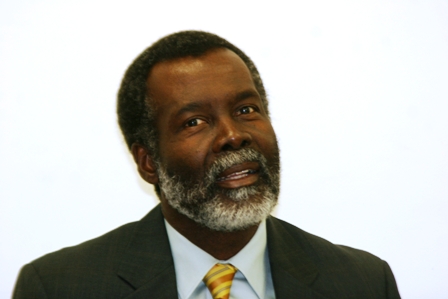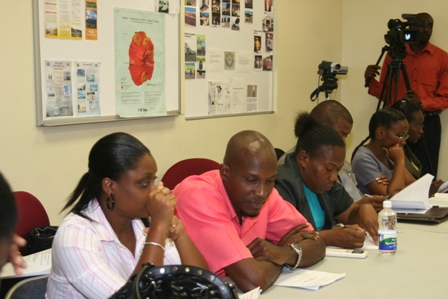OAS Rep. Greene calls for integrated school safety programme for St. Kitts and Nevis

NIA-CHARLESTOWN NEVIS (March 21, 2011) — A school safety programme should become integrated in the national education curriculum in St. Kitts and Nevis. That view was expressed by Organisation of American States (OAS) Representative to St. Kitts and Nevis Mr. Starret Greene, when he delivered remarks at the commencement of a three-day School Safety Workshop at the Llewellyn Newton Disaster Management Facility at Long Point on March 21st, 2001.
The training formed part of the ongoing Natural Disaster Management and Mitigation Project for Nevis and was attended by teachers throughout the island. The programme is funded by the OAS/FEMCIDI, the United States Agency for International Development through the Office of Foreign Disaster Assistance (USAID/OFDA) and the Nevis Island Administration (NIA). Mr Greene said once in place, the school safety programmes should be tested regularly.
“It should be tested regularly to ensure that children are acquainted with its various components and to sensitise them of the need for full compliance should a disaster strike. Natural disasters are with us to stay. However, there are critical things we can do to minimise the effects on our environment and on our existence.
“The OAS is pleased that the activity held last week in St. Kitts and this event that commences today, will ensure that the School Safety Programme becomes an essential component of the Federation’s disaster preparedness mitigation and response regime,” he said.

Mr. Greene noted that the workshop in Nevis was another leg of the process to reactivate the School Safety Programme in St. Kitts and Nevis and both workshops should be viewed as sides of a penny.
He said the OAS was pleased to assist the Federation’s schools to put in place the requisite safeguards among others, would help to mitigate disaster whether they were natural or manmade.
The OAS Representative to St. Kitts and Nevis explained that children were the ones most impacted by the negative effects and fallout from natural disasters since they were among the ones most vulnerable in the community. Therefore, it was the society’s responsibility to protect them and ensure their complete safety during life threatening emergencies.
Mr. Greene contended that the OAS would receive support from USAID/OFDA for such a programme to be appropriately designed with considerations to the peculiar circumstances and special characteristics of a small island developing state like St. Kitts and Nevis; if it was well publicized through an effective public campaign; fully understood by school administrators and teachers; once it had the input and support of teachers, parents and school community; if it was tested at regular intervals; was sufficiently flexible , adequately funded; easy to implement or execute and was a programme that could boast the support of all stakeholders who made up the disaster management, mitigation and response community in the Federation.
Meantime, he said it was known that drills and related exercises conducted at regular intervals, were critical to saving lives at times of real emergencies and once children knew what to expect and how to react when disaster struck, there was likely to be less confusion, reduced panic, decreased fears and little uncertainty.
“Therefore, it seems right to expect that once a school safety programme is developed, school authorities will assume the responsibility to carry out mock exercises and do so without the urging of the Ministry of Education.
“The OAS is of the view that activities of this nature will help to determine the effectiveness of the programme, in terms of keeping the school population secure during times when it really matters,” Mr. Greene said.
He said no one wished to be adversely affected by natural disaster, however, the frequency of their occurrences coupled with their acute intensity were factors that challenged everyone to be always on the alert.
When one was in a state of readiness, Mr. Green said, they were better positioned to minimize the negative effects of disaster on the environment and could significantly reduce the threat to their own survival as well.
